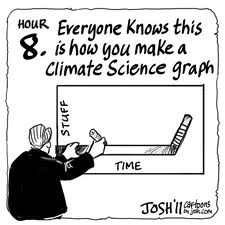
Promoters of a current ‘climate crisis’ often call modern warming and/or events within it, ‘unprecedented’. However, compared to events like this: “A Neanderthal would have experienced increases in the average temperature of several degrees over the course of their life” [explains Prof.], not much is presently going on. Climate variability can happen in different ways, and repeat over long timescales.
– – –
In recent geological history, the so-called Quaternary period, there have been repeated ice ages and warm periods, says Science Daily.
Researchers are able to determine past climate variability from the composition of climate records. In the case of the last glacial period 100,000 years ago, ice cores from Greenland in particular provide researchers with detailed data.
For example, Greenland ice cores show that there were repeated rapid increases in temperature.
“We are talking about increases of 5 to 10 degrees within 30 to 40 years on average in the case of Europe. A Neanderthal would have experienced increases in the average temperature of several degrees over the course of their life,” explains Prof. Dominik Fleitmann, Professor of Quaternary Geology at the University of Basel.
He calls the phenomena “climate hiccups.”
These Dansgaard-Oeschger events are well documented for the last glacial period, but the climate records from Greenland only cover the last 120,000 years.
It was therefore previously unknown whether these Dansgaard-Oeschger events also occurred during the penultimate glacial period 135,000 to 190,000 years ago.
Frederick Held, a PhD candidate in Fleitmann’s research group, was able to show that Dansgaard-Oeschger events also occurred during the penultimate glacial period using isotopic measurements on stalagmites.
He is the lead author of the study which was published in the scientific journal Nature Communications.
The North Atlantic as the source of change
The stalagmites examined originate from the Sofular Cave in Turkey, which is located in a region that is very sensitive to climate change.
The researchers therefore refer to it as a key region, as it is influenced by the winds of the North Atlantic and the Black Sea is just a few kilometers away.
“We used the isotopic composition in the stalagmites to determine the moisture sources from which they are formed — the Black Sea, the Mediterranean Sea and the North Atlantic,” explains Frederick Held.
For the first time, the evaluations carried out on the stalagmites from the Sofular Cave have proven that Dansgaard-Oeschger events also occurred during the penultimate glacial period.
“It was previously unknown whether these relatively brief temperature events actually happened in earlier glacial periods,” states Held.
However, they occurred less frequently in the penultimate glacial period than in the last one: “The temperature peaks are twice as far apart from one another, meaning there were longer cold phases between them.”
These temperature fluctuations originate in the North Atlantic, as the circulation of the ocean is a global conveyor belt for heat and can sometimes be stronger and sometimes weaker.
“For example, the circulation affects the exchange of heat between the atmosphere and the ocean, which, in turn, impacts the balance of heat in the Northern Hemisphere and air flows and rainfall,” explains Held.
He states that weakened circulation also reduces the quantity of CO2 which the ocean absorbs from the atmosphere.
These ocean currents were different in the penultimate glacial period than in the last one, which explains the different intervals between the Dansgaard-Oeschger events.
This shows that not all glacial periods are the same and not all warm periods are the same.
. . .
The geologist also hopes to clarify any outstanding questions by means of additional analyses. “For example, we do not yet know whether the increases in temperature were periodic or stochastic, in other words random.”
Full article here.
Image: Greenland ice core [credit: K. Makinson @ Wikipedia]






















